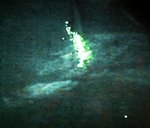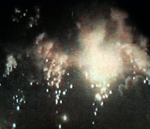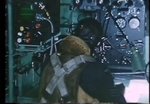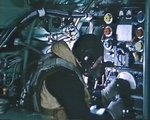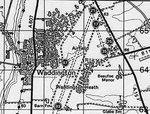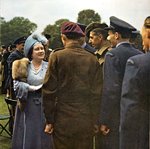diversdream
Airman
(Original Available on 463/467 RAAF Squadron Website, other Reserch own work)
From Our London Editor AWV King.
BOMBER STATION
SOMEWHERE IN ENGLAND
3 December 1943.
Superb in the savage beauty of its light, but terrifying as a spectacle of devastation by explosive and burning, was the scene in a portion of Berlin as it appeared last night from a Lancaster of one of the Australian bomber squadrons in which I flew.
Hundreds of searchlights probed the skies and coned several bombers.
"Scarecrow" flares soared up and burst into a cascade of light which turned night into day.
Other flares broke into ominous red and green orbs, and flak burst in angry blobs around us.
The skies over the target were indeed in turmoil, but the target area itself was in even greater turmoil as 4000lb bombs, "cookies", smashed amid the built-up area and thousands of incendiaries cascaded down and took a hold among the blocks of buildings in fantastic alphabetical designs.
Symbolic of the purpose of the attacks, one of the early strings of incendiaries flared up in an almost perfect V - for victory.
Other strings formed "I's", "T's", and "L's.
The "cookies" exploded in seemingly slow mushroom-like glows.
They burned a dull red for some time, and then died in plumes of smoke.
The pilot of the crew with whom I flew was Squadron-Leader William A Forbes RAAF, an old man at 23, whose parents live at Hornsby, and his wife lives at Bundaberg.
The Flight-engineer was Pilot Officer Frank Miller, of Laidley, near Brisbane .
The others comprised two Scots, two Englishmen, and a Canadian.
They were doing their 27th operation together, and their Lancaster 'G' for George its eleventh.
It had not been scarred, not even scratched on its previous 10 sorties, which were represented on the fuselage, not by orthodox bomb replicas but by foaming mugs of beer.
"Why that symbol", I asked Sergeant Laurie Parker, of Bundaberg, one of the ground crew, when I was standing to board "George".
Parker grinned, "Trips to the Land of Mugs - big mugs", he said, laconically.
Typically the Aussie sense of humour that is lost on the rest of the world.
The experienced crew brought "George" efficiently and uneventfully past heavily defended areas on the way to the "King of Targets".
Then the crux of the tense drama began.
Cloud protected us practically the whole way.
Then, 10 miles from the target, it became wispy.
Visibility was perfect over the target itself.
But if the break in the clouds made the job easier for the bombaimers, it enabled the defenders to concentrate hundreds of searchlights and light and heavy flak against the raiders, The Germans used all their defensive devices but we saw one raider perfectly coned in search lights without fighters attacking it or flak directed at it.
CONFUSION OF COLOURS
"George" was among the first waves of bombers over the target, which had been defined with remarkable clarity by the Pathfinder force a few minutes earlier with target-indicators of different colours.
The bombaimers' particular objective stood out like beacons amid a confusion of colours.
From the time we sighted them, about 10 miles out, until we passed beyond them was the most exciting ten minutes through which I have lived.
The two central figures in that brief period were Forbes and the bomb-aimer, Pilot Officer William Grime, of Ealing, London , two "bills" who co-operatively directed and instructed each other over the intercom phones.
I stood behind the imperturbable Forbes and watched the fascinatingly fantastic scene over his shoulder.
As soon as he sighted his target indicators, for which he was on the lookout, Forbes asked Grime whether he had seen them.
Grime answered confidently in the affirmative and then gave the pilot a slight alteration of course, adding:
"You can weave a bit, Bill".
Bill Forbes weaved to lessen the danger from flak, but it was only for seconds.
Then Forbes settled down to hold his plane to the level, undeviating run so essential for accurate bombing.
From Our London Editor AWV King.
BOMBER STATION
SOMEWHERE IN ENGLAND
3 December 1943.
Superb in the savage beauty of its light, but terrifying as a spectacle of devastation by explosive and burning, was the scene in a portion of Berlin as it appeared last night from a Lancaster of one of the Australian bomber squadrons in which I flew.
Hundreds of searchlights probed the skies and coned several bombers.
"Scarecrow" flares soared up and burst into a cascade of light which turned night into day.
Other flares broke into ominous red and green orbs, and flak burst in angry blobs around us.
The skies over the target were indeed in turmoil, but the target area itself was in even greater turmoil as 4000lb bombs, "cookies", smashed amid the built-up area and thousands of incendiaries cascaded down and took a hold among the blocks of buildings in fantastic alphabetical designs.
Symbolic of the purpose of the attacks, one of the early strings of incendiaries flared up in an almost perfect V - for victory.
Other strings formed "I's", "T's", and "L's.
The "cookies" exploded in seemingly slow mushroom-like glows.
They burned a dull red for some time, and then died in plumes of smoke.
The pilot of the crew with whom I flew was Squadron-Leader William A Forbes RAAF, an old man at 23, whose parents live at Hornsby, and his wife lives at Bundaberg.
The Flight-engineer was Pilot Officer Frank Miller, of Laidley, near Brisbane .
The others comprised two Scots, two Englishmen, and a Canadian.
They were doing their 27th operation together, and their Lancaster 'G' for George its eleventh.
It had not been scarred, not even scratched on its previous 10 sorties, which were represented on the fuselage, not by orthodox bomb replicas but by foaming mugs of beer.
"Why that symbol", I asked Sergeant Laurie Parker, of Bundaberg, one of the ground crew, when I was standing to board "George".
Parker grinned, "Trips to the Land of Mugs - big mugs", he said, laconically.
Typically the Aussie sense of humour that is lost on the rest of the world.
The experienced crew brought "George" efficiently and uneventfully past heavily defended areas on the way to the "King of Targets".
Then the crux of the tense drama began.
Cloud protected us practically the whole way.
Then, 10 miles from the target, it became wispy.
Visibility was perfect over the target itself.
But if the break in the clouds made the job easier for the bombaimers, it enabled the defenders to concentrate hundreds of searchlights and light and heavy flak against the raiders, The Germans used all their defensive devices but we saw one raider perfectly coned in search lights without fighters attacking it or flak directed at it.
CONFUSION OF COLOURS
"George" was among the first waves of bombers over the target, which had been defined with remarkable clarity by the Pathfinder force a few minutes earlier with target-indicators of different colours.
The bombaimers' particular objective stood out like beacons amid a confusion of colours.
From the time we sighted them, about 10 miles out, until we passed beyond them was the most exciting ten minutes through which I have lived.
The two central figures in that brief period were Forbes and the bomb-aimer, Pilot Officer William Grime, of Ealing, London , two "bills" who co-operatively directed and instructed each other over the intercom phones.
I stood behind the imperturbable Forbes and watched the fascinatingly fantastic scene over his shoulder.
As soon as he sighted his target indicators, for which he was on the lookout, Forbes asked Grime whether he had seen them.
Grime answered confidently in the affirmative and then gave the pilot a slight alteration of course, adding:
"You can weave a bit, Bill".
Bill Forbes weaved to lessen the danger from flak, but it was only for seconds.
Then Forbes settled down to hold his plane to the level, undeviating run so essential for accurate bombing.

